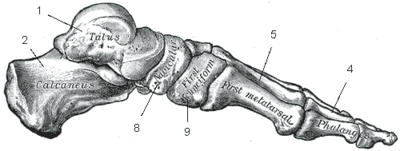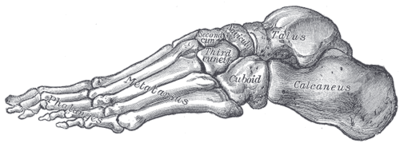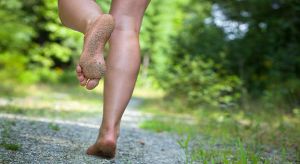Arches of the Foot
Original Editor - Evan Thomas
Top Contributors - Kim Jackson, Daniele Barilla, Evan Thomas, Uchechukwu Chukwuemeka, Lucinda hampton, Adam Vallely Farrell, Vidya Acharya, Mariam Hashem and WikiSysop
Introduction[edit | edit source]
The foot has three arches: two longitudinal (medial and lateral) arches and one anterior transverse arch. These arches are formed by the tarsal and metatarsal bones and are supported by the ligaments and tendons in the foot.
The arches shape is designed in a similar manner to spring; bears the weight of the body and absorbs the shock that is produced with locomotion. The foot's flexibility conferred by the arches is what facilitates everyday loco-motor functions such as walking and sprinting. The energy-sparing spring theory of the foot’s arch has become central to interpretations of the foot’s mechanical function and evolution. The metabolic energy saved by the arch is largely explained by the passive-elastic work it supplies that would otherwise be done by active muscle.
Anatomy Medial, Lateral and Longitudinal arch[edit | edit source]
Medial Arch[edit | edit source]
The medial arch is the higher of the two longitudinal arches. It is made up of the calcaneus, the talus, the navicular, the three cuneiforms, and the first, second, and third metatarsals. Its summit is at the superior articular surface of the talus, and its two extremities or piers, on which it rests in standing, are the tuberosity on the plantar surface of the calcaneus posteriorly and the heads of the first, second, and third metatarsal bones anteriorly.
The chief characteristic of this arch is its elasticity, due to its height and to the number of small joints between its component parts. Its weakest part, i. e., the part most liable to yield from overpressure, is the joint between the talus and navicular, but this portion is braced by the plantar calcaneonavicular ligament, which is elastic and is thus able to quickly restore the arch to its pristine condition when the disturbing force is removed.
The ligament is strengthened medially by blending with the deltoid ligament of the ankle joint and is supported inferiorly by the tendon of the Tibialis posterior, which is spread out in a fan-shaped insertion and prevents undue tension of the ligament or such an amount of stretching as would permanently elongate it. The arch is further supported by the plantar aponeurosis, by the small muscles in the sole of the foot, by the tendons of the Tibialis anterior and posterior and Peronæus longus, and by the ligaments of all the articulations involved. [2]
Lateral Arch[edit | edit source]
The lateral arch is the flatter of the two longitudinal arches and lies on the ground in the standing position. It is composed of the calcaneus, the cuboid, and the fourth and fifth metatarsals. Its summit is at the talocalcaneal articulation, and its chief joint is the calcaneocuboid, which possesses a special mechanism for locking, and allows only a limited movement. The most marked features of this arch are its solidity and its slight elevation; two strong ligaments, the long plantar and the plantar calcaneocuboid, together with the Extensor tendons and the short muscles of the little toe, preserve its integrity.[2]
While these medial and lateral arches may be readily demonstrated as the component antero-posterior arches of the foot, yet the fundamental longitudinal arch is contributed to by both, and consists of the calcaneus, cuboid, third cuneiform, and third metatarsal: all the other bones of the foot may be removed without destroying this arch.[2]
Transverse Arch[edit | edit source]
In addition to the longitudinal arches the foot presents a series of transverse arches. The transverse arch is located in the coronal plane of the foot. At the posterior part of the metatarsus and the anterior part of the tarsus the arches are complete, but in the middle of the tarsus they present more the characters of half-domes the concavities of which are directed downward and medial, so that when the medial borders of the feet are placed in apposition a complete tarsal dome is formed. The transverse arches are strengthened by the interosseous, plantar, and dorsal ligaments, by the short muscles of the first and fifth toes (especially the transverse head of the Adductor hallucis), and by the Peroneous longus, whose tendon stretches across between the piers of the arches.[2]
Clinical Relevance[edit | edit source]
Patients commonly present with foot and ankle problems, and many find it challenging to assess these patients. This is probably related to the complexity and multiplicity of joints in this part of the body. There are 26 bones, 33 Joints, more than 100 ligaments, tendons and muscles in each foot. On average, we walk 10000 steps per day, 1000000 steps per year and 115000 miles in our lifetime. The foot stands 3-4 times body weight during running[3]
As an example a person with a low longitudinal arch, or flat feet often stands and walks with their feet in a pronated position, where the foot everts. This makes the person susceptible to heel pain, arch pain, and plantar fasciitis.
With high arches you have less surface area for absorbing impact and you place excessive pressure on your rearfoot and forefoot areas. This can make you susceptible to foot conditions such as heel pain, metatarsalgia, or plantar fasciitis.
Assessment of Arches[edit | edit source]
For a detailed assessment of the arches of the foot see below:
Common Foot Postures and Associated Conditions[edit | edit source]
- Pes planus (flat foot)
- Pes planus is a common condition in which the longitudinal arches have been lost. Arches do not develop until about 2-3 years of age, meaning flat feet during infancy is normal.
- For most individuals, being flat-footed causes few, if any, symptoms.
- Treatment, if indicated, generally involves the use of arch-supporting inserts for shoes.
- Pes cavus (claw foot)
- Pes cavus is a foot condition characterised by an unusually high medial longitudinal arch.
- Due to the higher arch, the body's normal ability to absorb shock during walking is diminished and there is a greater degree of stress placed on the ball and heel of the foot.
- Treatment is usually provided by supporting the foot through the use of special shoes or sole cushioning inserts. Reducing the load the foot can bear is also advantageous. This is most effective through weight loss.
- Hallux Valgus
- Hammer Toe
- Club foot (talipes equinovarus)
- Metatarsalgia
- Morton's Toe and Morton's Neuroma
- Plantar Fasciitis
References[edit | edit source]
- ↑ Brian Abelsome Arches of the foot Available from: https://www.youtube.com/watch?v=j59yk3tdQdM (last accessed 9.10.2019)
- ↑ 2.0 2.1 2.2 2.3 Henry Gray (1821–1865). Anatomy of the Human Body. Philadelphia: Lea & Febiger;1918.
- ↑ Alazzawi S, Sukeik M, King D, Vemulapalli K. Foot and ankle history and clinical examination: A guide to everyday practice. World journal of orthopedics. 2017;8(1):21-29










